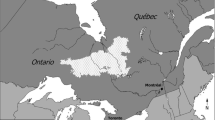Current forestry policy has multiple objectives including wood production, nature conservation, landscape, recreation and environment protection. There are about 190 000 ha of planted forest on deep peat and another 315 000 ha on shallower peat. Deep peat covers just over 2 million ha in Britain, so the area planted is some 9.5%. The paper describes how modern silvicultural practices are designed to achieve these multiple benefits of forests on peatland.
Similar content being viewed by others
References
Avery B.W. (1990) The Soils of the British Isles. Wallingford: CAB International.
Bevan D. (1987) Forest Insects. Forestry Commission Handbook, Number 1, London: HMSO.
Calder I.R. and Newson M.D. (1979) Land use and upland water resources in Britain — a strategic look. Water Res. Bull. 15, 1628–39.
Carey M.L., McCarthy R.G. and Miller H.G. (1988) More on nursing mixtures. Irish Forest. 45. 7–20.
Coutts M.P. and Philipson J.J. (1978) Tolerance of tree roots to waterlogging. I. Survival of Sitka spruce and lodgepole pine. New Phytol. 80, 63–9.
Day K.R., Leather S.R. and Lines R. (1991) Damage by Zeiraphera diniana (Lepidoptera: Tortricidae) to lodgepole pine (Pinus contorta) of various provenances. Forest Ecol. Manag. 44, 133–45.
Forestry Commission (1989) Forest Landscape Design Guidelines. Edinburgh: Forestry Commission.
Forestry Commission (1990) Forest Nature Conservation Guidelines. London: HMSO.
Forestry Commission (1991a) Forestry Policy for Great Britain. Edinburgh: Forestry Commission.
Forestry Commission (1991b) Woodlands Grants Scheme — Applicants Pack. Edinburgh: Forestry Commission.
Harriman R. (1978) Nutrient leaching from fertilised forest watersheds in Scotland. J. Appl. Ecol. 15, 933–42.
Leather S.R. (1992) Forest management practice to minimize the impact of the Pine Beauty moth. Forest. Comm. Res. Inf. Note 217, 1–3.
Lindsay R.A., Charman D.J., Everingham F., O'Reilly R.M., Palmer M.A., Rowell T.A. and Stroud D.A. (1988) The Flow Country. Peterborough: Nature conservancy Council.
Miller K.F. (1985) Windthrow Hazard Classification. Forestry Commission Leaflet. Number 85. London: HMSO.
Miller K.F. and Quine C.P. (1991) Wind. In Forestry Practice (B.G.Hibberd, ed.) chapter 10. pp. 139–46. forestry Commission Handbook Number 6. London: HMSO.
Nicholson I.A., Robertson R.A. and Robinson M. (1989) The effects of drainage on the hydrology of a peat bog. Int. Peat J. 3, 59–83.
O'Carroll N. (1978) The nursing of Sitka spruce. I. Japanese larch. Irish Forest. 35, 60–5.
Petty S.J. and Avery M.I. (1990) Forest Bird Communities. Forestry Commission Occasional Paper, Number 26. Edinburgh: Forestry Commission.
Philipson J.J. and Coutts M.P. (1978) The tolerance of tree roots to waterlogging. III. Oxygen transport to lodgepole pine and Sitka spruce roots of primary structure. New Phytol. 80, 341–9.
Pyatt D.G. (1990) Long-term prospects for forests on peatland. Scot. Forest. 44, 19–25.
Pyatt D.G. (1991) Deep Peats. In Report on Forest Research 1991. London: Forestry Commission.
Pyatt D.G., Anderson A.R. and Ray D. (1987) Deep peats. In Report on Forest Research 1987. London: Forestry Commission.
Pyatt D.G. and John A.L. (1989) Modelling volume changes in peat under conifer plantations. J. Soil Sci. 40, 695–706.
Pyatt D.G., John A.L., Anderson A.R. and White I.M.S. (1992) The drying of blanket peatland by 20-year old conifer plantations at Rumster Forest, Caithness. In Peatland Ecosystems and Man (O.M.Bragg, P.D.Hulme, H.A.P.Ingram and R.A.Robertson, eds). pp. 153–8. Dundee: University of Dundee Press.
Robinson M. (1986) Changes in catchment runoff following drainage and afforestation. J. Hydrol. 86, 71–84.
Robinson M. and Hind P.D. (1991) The coalburn catchment experiment. Proc. North Eng. Soils Discuss. Group 26, 9–26.
Rose D.R. (1991) Shoot dieback of lodgepole pine caused by Ramichloridium pini. Research Information Note, Number 207. London: Forestry Commission Research Division.
Ryan E.A. and Alexander I.J. (1992) Mycorrhizal aspects of improved growth of spruce when grown in mixed stands of heathlands. In Mycorrhizas in Ecosystems (D.J.Read, D.H.Lewis, A.H.Fitter and I.J.Alexander, eds) pp. 237–47. Wallingford: CAB International.
Spencer J.B. (1991) Soft ground harvesting — review of methods to minimise site damage. In Forestry Commission Work Study Branch Report, Number 35, (Northern Region Team). Edinburgh: Forestry Commission. Restricted circulation.
Stroud D.A., Reed T.M., Pienkowski M.W. and Lindsay R.A. (1987) Birds, Bogs and Forestry. Peterborough: Nature Conservancy Council.
Swift, D.W. (1986) Phosphorus Run-Off from Glenorchy Forest. Medmenham: Water Research Centre Report (Ref. PRV 1699-M).
Taylor C.M.A. (1985) The return of nursing mixtures. Forest. Brit. Timb. 14, 18–9.
Taylor C.M.A. (1990) The nutrition of Sitka spruce on upland restock sites. Forest. Comm. Res. Inf. Note 164, 1–4.
Taylor C.M.A. (1991) Forest fertilisation in Britain. Forestry Commission Bulletin, Number 95. London: HMSO.
Taylor C.M.A. and Tabbush P.M. (1990) Nitrogen deficiency in Sitka spruce plantations. forestry Commission Bulletin, Number 89. London: HMSO.
Wall M. and Smith S. (1990) Harvesting of lodgepole pine: desk study. Forestry Commission Work Study Branch Report, Number 33. (Northern Region Team). Edinburgh: Forestry Commission. Restricted circulation.
Worrell R. (1987) Predicting the productivity of Sitka spruce on upland sites in Northern Britain. Forestry Commission Bulletin, Number 72. London: HMSO.
Author information
Authors and Affiliations
Rights and permissions
About this article
Cite this article
Pyatt, D.G. Multi-purpose forests on peatland. Biodivers Conserv 2, 548–555 (1993). https://doi.org/10.1007/BF00056748
Received:
Accepted:
Issue Date:
DOI: https://doi.org/10.1007/BF00056748




